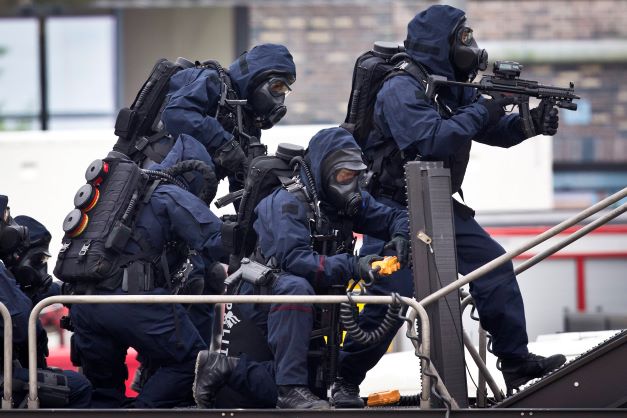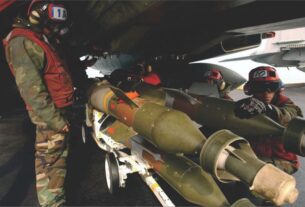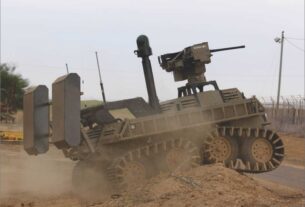NBC warfare and its challenges
The proliferation of nuclear, biological, and chemical weapons is widely recognized as the most serious threat to the national security of the many countries in the world. NBC Proliferation is recognized as a serious threat across the operational spectrum-from the deployment of forces to post-hostility activities
Given the potential deadliness and costliness of even a single CBRN attack, and the relative ease with which malicious actors could obtain many of the materials and know-how required to build CBRN weapons, it is important to assess the current global threat of use of these weapons in light of society’s resilience and vulnerabilities, and emerging technologies.
Today’s heightened terrorist and saboteur threat, combined with the significant potential for CBRN weapons to cause widespread disruption and fear, could increase the likelihood of these weapons being used by malicious actors. Despite this, there have been relatively few large- or even medium-scale incidents of CBRN terrorism or sabotage in the 20th and 21st centuries. The probability and nature of this threat varies geographically, and is linked to the capabilities, intentions for use and the consequences of use for a potential perpetrator.
Technological developments
The nations of the world confront serious and immediate threats from the global presence of thousands of nuclear weapons and chemical weapons. They also face the possibility that some nation or group still has or soon could have biological weapons. A wide variety of delivery mechanisms for these weapons exists, including ballistic missiles, cruise missiles, aircraft, artillery, ships, trucks, and envelopes. There is also now the added danger that terrorist organizations could kill thousands with these weapons or by sabotaging critical urban and industrial infrastructures. Although a terrorist attack on these infrastructures using conventional weapons is the most likely threat , the explosion of a nuclear weapon would be the most devastating.
Technological developments – including those in nanotechnology, synthetic biology and chemicals, cyber technology and 3D printing – could enable hostile actors to develop weapons that are cheaper, more powerful and easier to use. However, these same advances also have the potential to enhance detection, and reduce the destructive and disruptive capacity of CBRN weapons.
Nuclear, biological, and chemical weapons were twentieth-century inventions. There is nothing new, of course, about mass destruction. From ancient times, a military campaign often meant the slaughter of tens of thousands of soldiers and civilians. As the Industrial Revolution mechanized warfare, the industrialized nations sought ways to more efficiently kill armored troops or unprotected populations dispersed over wide areas and to annihilate military and economic targets. Military researchers produced weapons that could deliver poison gas, germs, and nuclear explosions with artillery, aerial bombs, and, later, missiles.
However, throughout history, countries and factions have developed and used chemical, biological, and radiological (CBR) warfare. In WWI, chlorine gas was used, which forced the development of the gas mask. In WWII, nuclear weapons were used for the first time. During WWII, many nations began developing chemical and biological agents asawarfare tool. More recently, a nerve agent was used in Japan’s subway system, and blister agents were used on the Kurds during the Iraq and Iran war
Non-proliferation objectives have long been given high priority by the United States, which has taken the lead in establishing international legal norms against the possession and the use of NBC weapons. Since after the September 11 terrorist attack in the United States, the nature of threat caused by nuclear, biological and chemical (NBC) weapons changed substantially from that in the past. In addition the preparation for the possible military attack with NBC weapons in the traditional context of nation-to-nation, international community began to review the need for defending against the threat of chemical, biological, radioactive, and nuclear (CBRN) attack by non-state actors including international terrorists. The US faces a small number of rogue states that either have or are working to acquire weapons of mass destruction, including North Korea, Iran, Iraq and Libya. US and allied counterproliferation programmes are needed to reduce the threat posed by these countries.
The proliferation of NBC weapons, and of increasingly capable ballistic and cruise missiles as delivery systems of choice, represents a central threat to US security interests and the use of force as an instrument of US national strategy. In response to this growing threat, the United States had pursued a two-track approach. The first, designed to prevent proliferation, consists of bolstering traditional non-proliferation efforts—such as arms control, export controls, and security assistance and assurances—to dissuade any potential proliferator from pursuing NBC and missile programs. The second track, referred to as counterproliferation, consists of defence initiatives across a broad range of activities—from doctrine to training and leadership development to acquisition—designed to protect against the strategic and tactical consequences of proliferation should prevention fail.
Type of weapons
There have been various debates on the threat of nuclear weapons and radiological weapons. Nuclear weapons are the most deadly weapons ever invented-the only true weapons of mass destruction. A single, compact nuclear device can instantly devastate a midsized city. Nuclear weapons are also the most difficult of the three types of weapons to manufacture or acquire
A nuclear weapon is a device with explosive energy, most or all of which is derived from fission or a combination of fission and fusion processes. Explosions from such devices cause catastrophic damage due both to the high temperatures and ground shocks produced by the initial blast and the lasting residual radiation. Blast produces an intense shock wave and high winds that create flying debris. It may collapse shelters and some fighting positions.
Thermal radiation causes burns and starts fires. The bright flash at the time of the explosion can cause a temporary loss of vision or permanent eye damage if you look at the explosion, especially at night.
Nuclear radiation can cause casualties and delay movements. It may last for days and cover large areas of terrain. It occurs in two stages: initial and residual.
Nuclear weapons rely on nuclear energy produced by either fission or a combination of fission and fusion of atomic nuclei. Nuclear weapons have not been detonated in armed conflict since 1945, and most concerns today tend to centre on states selling a nuclear weapon to terrorist organisations, or the security of highly radioactive nuclear material (uranium and plutonium) that could be stolen for use in an improvised nuclear device (IND).
In recent years, the increase in biological threats represent a growing concern for the international community. Biological weapons are weapons that intentionally use living organisms to kill. They are second only to nuclear weapons in their potential to cause mass casualties. It is often difficult to get a complete picture of which countries or groups have biological weapons or programs.
During the past several decades, terrorist attempts to acquire biological agents have fallen short of successful weaponization. Almost all threats to use biological agents—including hundreds of terrorist anthrax hoaxes against abortion clinics and other targets in the United States-have been false alarms. Biological weapons intentionally disseminate agents of infectious diseases and of conditions that would otherwise appear only naturally or not at all. These agents can be divided into bacteria (such as anthrax), viruses (such as smallpox), rickettsiae (such as Q fever), chlamydia, fungi, and toxins (such as ricin).
Biological weapons, also referred to as bioweapons, are deadly pathogens – bacteria, icroorganisms or viruses – or toxins which can be deliberately released in order to inflict harm. Biological weapons can be disseminated through inhalation, ingestion or skin absorption. Unlike chemical agents, biological agents can be grown from a tiny initial supply.5 The suitability of different pathogens and toxins for use as bioweapons depends on the motivation of the user; some biological agents might be better suited to affecting large numbers of people, such as the highly contagious severe acute respiratory syndrome (SARS) virus, while others, such as Ebola, might be less contagious but more deadly for those they affect.
Defences against biological weapons require medical countermeasures, detection, surveillance, and physical protection. Despite such circumstances, there will not be, in reality, a constant sufficient stockpile of vaccines and preventive agents for the variety of pathogens, bacteria, and toxins
Chemical agents are like poisonous pesticides, but are far more powerful. They are meant to kill or injure you and are released to cover large areas. They may be released as gases, liquids, or sprays. The enemy may use a mixture of agents to cause confusion and casualties. Artillery, mortars, rockets, missiles, aircraft, bombs, and land mines can deliver the agents.
CW agents are used to produce death, injury, temporary incapacitation, or irritation effects. Chemical agents are more broadly categorised according to their effects on the human body. Some of the most well-known categories are: nerve agents, such as sarin and VX; blood agents, such as hydrogen cyanide; blister agents, such as sulphur mustard and other mustard agents; choking agents, such as phosgene; and irritants, such as tear gas. Skin exposure to some agents may cause blistering, while other agents will cause lung damage if inhaled.
Radiological weapons disperse radioactive material using conventional methods, which may include an improvised explosive device. This is called a radiological dispersal device (RDD) – more commonly known as a ‘dirty bomb’. While the majority of immediate fatalities in such an attack would be likely to be caused by the explosion itself rather than the levels of radiation, the exposure of people and the environment to radioactive contamination would cause massive disruption and have a severe psychological impact on those affected. Another radiological threat relates to the vulnerability of nuclear power plants to acts of sabotage or terrorist attacks.
The fact that CBRN weapons have been used in the past in almost all parts of the world is indicative of a real threat. States with scientists and engineers with practical knowledge of CBRN materials or states experiencing domestic or international turmoil are considered to pose the greatest security threat. In such conditions, hazardous materials could fall into the hands of terrorist groups or saboteurs for use in urban areas or near critical infrastructure, which could impair and impact global economy and security.
Although CBRN attacks are rare, the threat is dynamic, and effective risk management requires co-operation, vigilance and innovation. Governments and industries can increase resilience to attacks by strengthening existing security measures – particularly around chemical facilities and critical infrastructure – ensuring laboratory security, safety and safeguards, and introducing alternatives to radioactive materials in non-military locations such as hospitals.
In the conventional context, it is essential that all states take effective measures against NBC weapons in light of the threat of WMD proliferation. Comprehensive responses are needed which take into account a wider scope of threats, such as regional conflict, asymmetric warfare, and catastrophic acts of terrorism, coupled with rapid advancements in science and technology and the proliferation of knowhow that lead to mass destruction. CBRN defence is a concept that is broad in scope and refers to a comprehensive set of measures taken to deal with various CBRN scenarios that could take place in reality, implemented through the coordination of various sectors of society.




